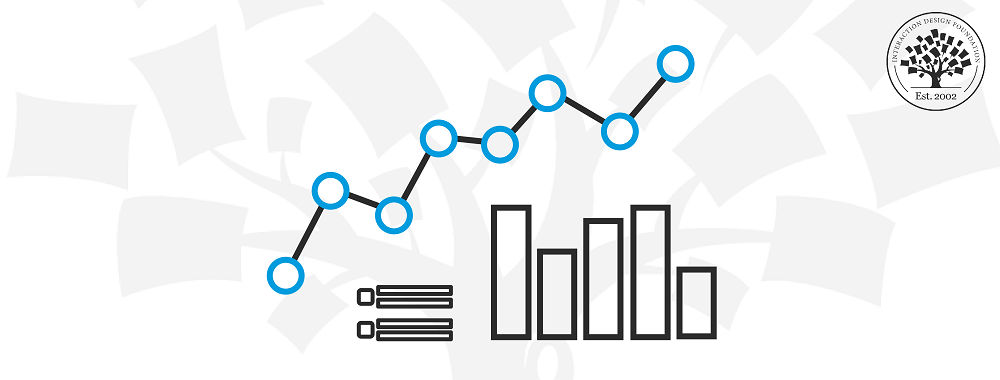Big or small, companies now expect their decisions to be data-driven. The world is growing and relying more on data. There is a greater need for professionals who know data analysis techniques.
Data analysis is a valuable skill that empowers you to make better decisions. This skill serves as a powerful catalyst in your professional and personal life. From personal budgeting to analyzing customer experiences, data analysis is the stepping stone to your career advancement.
So, whether you’re looking to upskill at work or kickstart a career in data analytics, this article is for you. We will discuss the best data analysis techniques in detail. To put all that into perspective, we’ll also discuss the step-by-step data analysis process.
Let’s begin.
What is Data Analysis?
Data analysis is collecting, cleansing, analyzing, presenting, and interpreting data to derive insights. This process aids decision-making by providing helpful insights and statistics.
The history of data analysis dates back to the 1640s. John Grant, a hatmaker, started collecting the number of deaths in London. He was the first person to use data analysis to solve a problem. Also, Florence Nightingale, best known as a nurse from 1854, made significant contributions to medicine through data analysis, particularly in public health and sanitation.
This simple practice of data analysis has evolved and broadened over time. “Data analytics” is the bigger picture. It employs data, tools, and techniques (covered later in this article) to discover new insights and make predictions.
Why is Data Analysis so Important Now?
How do businesses make better decisions, analyze trends, or invent better products and services?
The simple answer: Data Analysis. The distinct methods of analysis reveal insights that would otherwise get lost in the mass of information. Big data analytics is getting even more prominent owing to the below reasons.
1. Informed Decision-making
The modern business world relies on facts rather than intuition. Data analysis serves as the foundation of informed decision-making.
Consider the role of data analysis in UX design, specifically when dealing with non-numerical, subjective information. Qualitative research delves into the 'why' and 'how' behind user behavior, revealing nuanced insights. It provides a foundation for making well-informed decisions regarding color, layout, and typography. Applying these insights allows you to create visuals that deeply resonate with your target audience.
2. Better Customer Targeting and Predictive Capabilities
Data has become the lifeblood of successful marketing. Organizations rely on data science techniques to create targeted strategies and marketing campaigns.
Big data analytics helps uncover deep insights about consumer behavior. For instance, Google collects and analyzes many different data types. It examines search history, geography, and trending topics to deduce what consumers want.
3. Improved Operational Efficiencies and Reduced Costs
Data analytics also brings the advantage of streamlining operations and reducing organizational costs. It makes it easier for businesses to identify bottlenecks and improvement opportunities. This enables them to optimize resource allocation and ultimately reduce costs.
Procter & Gamble (P&G), a leading company, uses data analytics to optimize their supply chain and inventory management. Data analytics helps the company reduce excess inventory and stockouts, achieving cost savings.
4. Better Customer Satisfaction and Retention
Customer behavior patterns enable you to understand how they feel about your products, services, and brand. Also, different data analysis models help uncover future trends. These trends allow you to personalize the customer experience and improve satisfaction.
The eCommerce giant Amazon learns from what each customer wants and likes. It then recommends the same or similar products when they return to the shopping app. Data analysis helps create personalized experiences for Amazon customers and improves user experience.
Enhance your knowledge by understanding “when” and “why” to use data analytics.
Types of Data Analysis Methods
“We are surrounded by data, but starved for insights.”
— Jay Baer, Customer Experience Expert & Speaker
The above quote summarizes that strategic analysis must support data to produce meaningful insights.
Before discussing the top data analytics techniques, let’s first understand the two types of data analysis methods.
1. Quantitative Data Analysis
As the name suggests, quantitative analysis involves looking at the complex data, the actual numbers, or the rows and columns. Let’s understand this with the help of a scenario.
Your e-commerce company wants to assess the sales team’s performance. You gather quantitative data on various key performance indicators (KPIs). These KPIs include
The number of units sold.
Sales revenue.
Customer acquisition costs.
By analyzing these numeric data points, the company can calculate:
Monthly sales growth.
Average order value.
Return on investment (ROI) for each sales representative.
How does it help?
The quantitative analysis can help you identify:
Top-performing sales reps
Best-selling products.
Most cost-effective customer acquisition channels.
The above metrics help the company make data-driven decisions and improve its sales strategy.
2. Qualitative Data Analysis
There are situations where numbers in rows and columns are impossible to fit. This is where qualitative research can help you understand the data’s underlying factors, patterns, and meanings via non-numerical means. Let’s take an example to understand this.
Imagine you’re a product manager for an online shopping app. You want to improve the app’s user experience and boost user engagement. You have quantitative data that tells you what's going on but not why. Here’s what to do:
Collect customer feedback through interviews, open-ended questions, and online reviews.
Conduct in-depth interviews to explore their experiences.
Watch this instructional video to elevate your interview preparation to a more professional level.
How does it help?
By reading and summarizing the comments, you can identify issues, sentiments, and areas that need improvement. This qualitative insight can guide you to identify and work on areas of frustration or confusion.
Learn more about quantitative and qualitative user research in this video.
10 Best Data Analysis and Modeling Techniques
We generate over 120 zettabytes daily. That’s about 120 billion copies of the entire Internet in 2020, daily. Without the best data analysis techniques, businesses of all sizes will never be able to collect, analyze, and interpret data into real, actionable insights.
Now that you have an overarching picture of data analysis, let’s move on to the nitty-gritty: top data analysis methods.
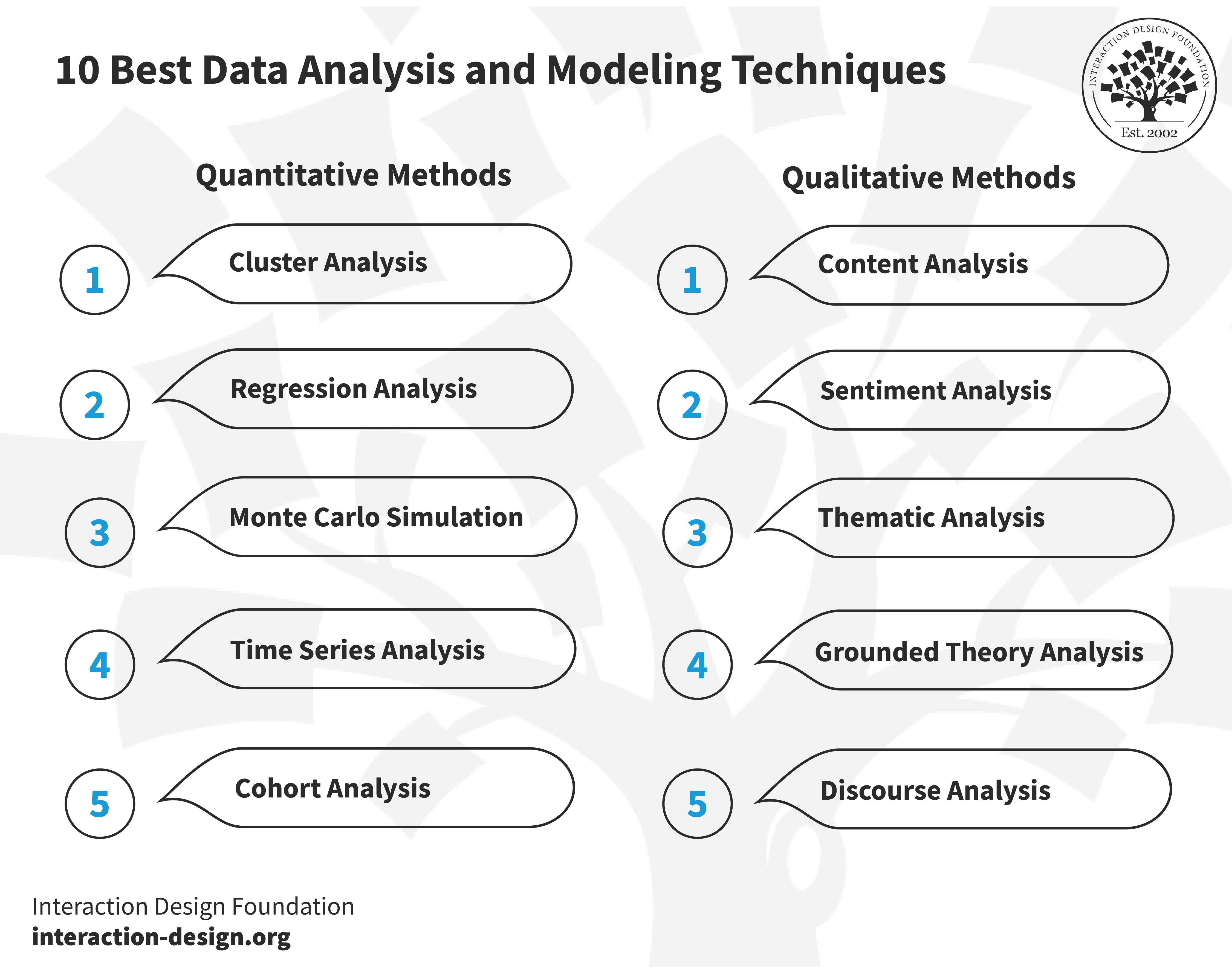
© Interaction Design Foundation, CC BY-SA 4.0
Quantitative Methods
1. Cluster Analysis
Also called segmentation or taxonomy analysis, this method identifies structures within a dataset. It’s like sorting objects into different boxes (clusters) based on their similarities. The data points within a similar group are similar to each other (homogeneous). Likewise, they’re dissimilar to data points in another cluster(heterogeneous).
Cluster analysis aims to find hidden patterns in the data. It can be your go-to approach if you require additional context to a trend or dataset.
Let’s say you own a retail store. You want to understand your customers better to tailor your marketing strategies. You collect customer data, including their shopping behavior and preferences.
Here, cluster analysis can help you group customers with similar behaviors and preferences. Customers who visit your store frequently and shop a lot may form one cluster. Customers who shop infrequently and spend less may form another cluster.
With the help of cluster analysis, you can target your marketing efforts more efficiently.
2. Regression Analysis
Regression analysis is a powerful data analysis technique. It is quite popular in economics, biology, biology, and psychology. This technique helps you understand how one thing (or more) influences another.
Suppose you’re a manager trying to predict next month’s sales. Many factors, like the weather, promotions, or the buzz about a better product, can affect these figures.
In addition, some people in your organization might have their own theory on what might impact sales the most. For instance, one colleague might confidently say, “When winter starts, our sales go up.” And another insists, “Sales will spike two weeks after we launch a promotion.”
All the above factors are “variables.” Now, the “dependent variable” will always be the factor being measured. In our example—the monthly sales.
Next, you have your independent variables. These are the factors that might impact your dependent variable.
Regression analysis can mathematically sort out which variables have an impact. This statistical analysis identifies trends and patterns to make predictions and forecast possible future directions.
There are many types of regression analysis, including linear regression, non-linear regression, binary logistic regression, and more. The model you choose will highly depend upon the type of data you have
3. Monte Carlo Simulation
This mathematical technique is an excellent way to estimate an uncertain event’s possible outcomes. Interestingly, the method derives its name from the Monte Carlo Casino in Monaco. The casino is famous for its games of chance.
Let’s say you want to know how much money you might make from your investments in the stock market. So, you make thousands of guesses instead of one guess. Then, you consider several scenarios. The scenarios can be a growing economy or an unprecedented catastrophe like Covid-19.
The idea is to test many random situations to estimate the potential outcomes.
4. Time Series Analysis
The time series method analyzes data collected over time. You can identify trends and cycles over time with this technique. Here, one data set recorded at different intervals helps understand patterns and make forecasts.
Industries like finance, retail, and economics leverage time-series analysis to predict trends. It is so because they deal with ever-changing currency exchange rates and sales data.
Using time series analysis in the stock market is an excellent example of this technique in action. Many stocks exhibit recurring patterns in their underlying businesses due to seasonality or cyclicality. Time series analysis can uncover these patterns. Hence, investors can take advantage of seasonal trading opportunities or adjust their portfolios accordingly.
Time series analysis is part of predictive analytics. It can show likely changes in the data to provide a better understanding of data variables and better forecasting.
5. Cohort Analysis
Cohort analysis also involves breaking down datasets into relative groups (or cohorts), like cluster analysis. However, in this method, you focus on studying the behavior of specific groups over time. This aims to understand different groups’ performance within a larger population.
This technique is popular amongst marketing, product development, and user experience research teams.
Let’s say you’re an app developer and want to understand user engagement over time. Using this method, you define cohorts based on a familiar identifier. This identifier can be the demographics, app download date, or users making an in-app purchase. In this way, your cohort represents a group of users who had a similar starting point.
With the data in hand, you analyze how each cohort behaves over time. Do users from the US use your app more frequently than people in the UK? Are there any in-app purchases from a specific cohort?
This iterative approach can reveal insights to refine your marketing strategies and improve user engagement.
Qualitative Methods
6. Content Analysis
When you think of “data” or “analysis,” do you think of text, audio, video, or images? Probably not, but these forms of communication are an excellent way to uncover patterns, themes, and insights.
Widely used in marketing, content analysis can reveal public sentiment about a product or brand. For instance, analyzing customer reviews and social media mentions can help brands discover hidden insights.
There are two further categories in this method:
Conceptual analysis: It focuses on explicit data. For example, the number of times a word repeats in a content.
Relational analysis: It examines the relationship between different concepts or words and how they connect. It's not about counting but about understanding how things fit together. A user experience technique called card sorting can help with this.
This technique involves counting and measuring the frequency of categorical data. It also studies the meaning and context of the content. This is why content analysis can be both quantitative and qualitative.
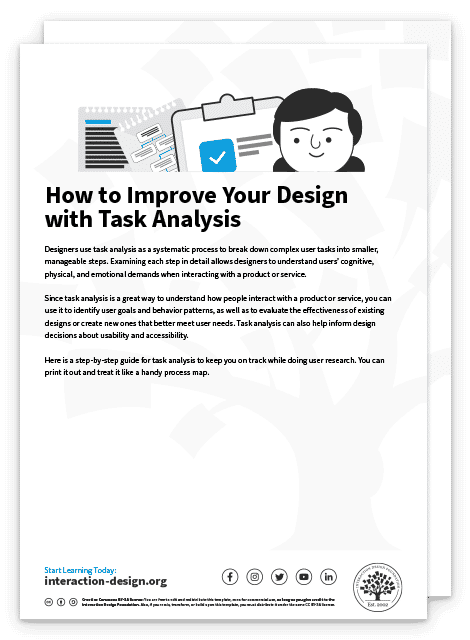

7. Sentiment Analysis
Also known as opinion mining, this technique is a valuable business intelligence tool. It can assist you to enhance your products and services. The modern business landscape has substantial textual data, including emails, social media comments, website chats, and reviews. You often need to know whether this text data conveys a positive, negative, or neutral sentiment.
Sentiment Analysis tools help scan this text to determine the emotional tone of the message automatically. The insights from sentiment analysis are highly helpful in improving customer service and elevating brand reputation.
8. Thematic Analysis
Whether you’re an entrepreneur, a UX researcher, or a customer relationship manager—thematic analysis can help you better understand user behaviors and needs.
The thematic technique analyzes large chunks of text data such as transcripts or interviews. It then groups them into themes or categories that come up frequently within the text. While this may sound similar to content analysis, it’s worth noting that the thematic method purely uses qualitative data.
Moreover, it is a very subjective technique since it depends upon the researcher’s experience to derive insights.
9. Grounded Theory Analysis
Think of grounded theory as something you, as a researcher, might do. Instead of starting with a hypothesis and trying to prove or disprove it, you gather information and construct a theory as you go along.
It's like a continuous loop. You collect and examine data and then create a theory based on your discovery. You keep repeating this process until you've squeezed out all the insights possible from the data. This method allows theories to emerge naturally from the information, making it a flexible and open way to explore new ideas.
Grounded theory is the basis of a popular user-experience research technique called contextual enquiry.
10. Discourse Analysis
Discourse analysis is popular in linguistics, sociology, and communication studies. It aims to understand the meaning behind written texts, spoken conversations, or visual and multimedia communication. It seeks to uncover:
How individuals structure a specific language
What lies behind it; and
How social and cultural practices influence it
For instance, as a social media manager, if you analyze social media posts, you go beyond the text itself. You would consider the emojis, hashtags, and even the timing of the posts. You might find that a particular hashtag is used to mobilize a social movement.
The Data Analysis Process: Step-by-Step Guide
You must follow a step-by-step data analytics process to derive meaningful conclusions from your data. Here is a rundown of five main data analysis steps:
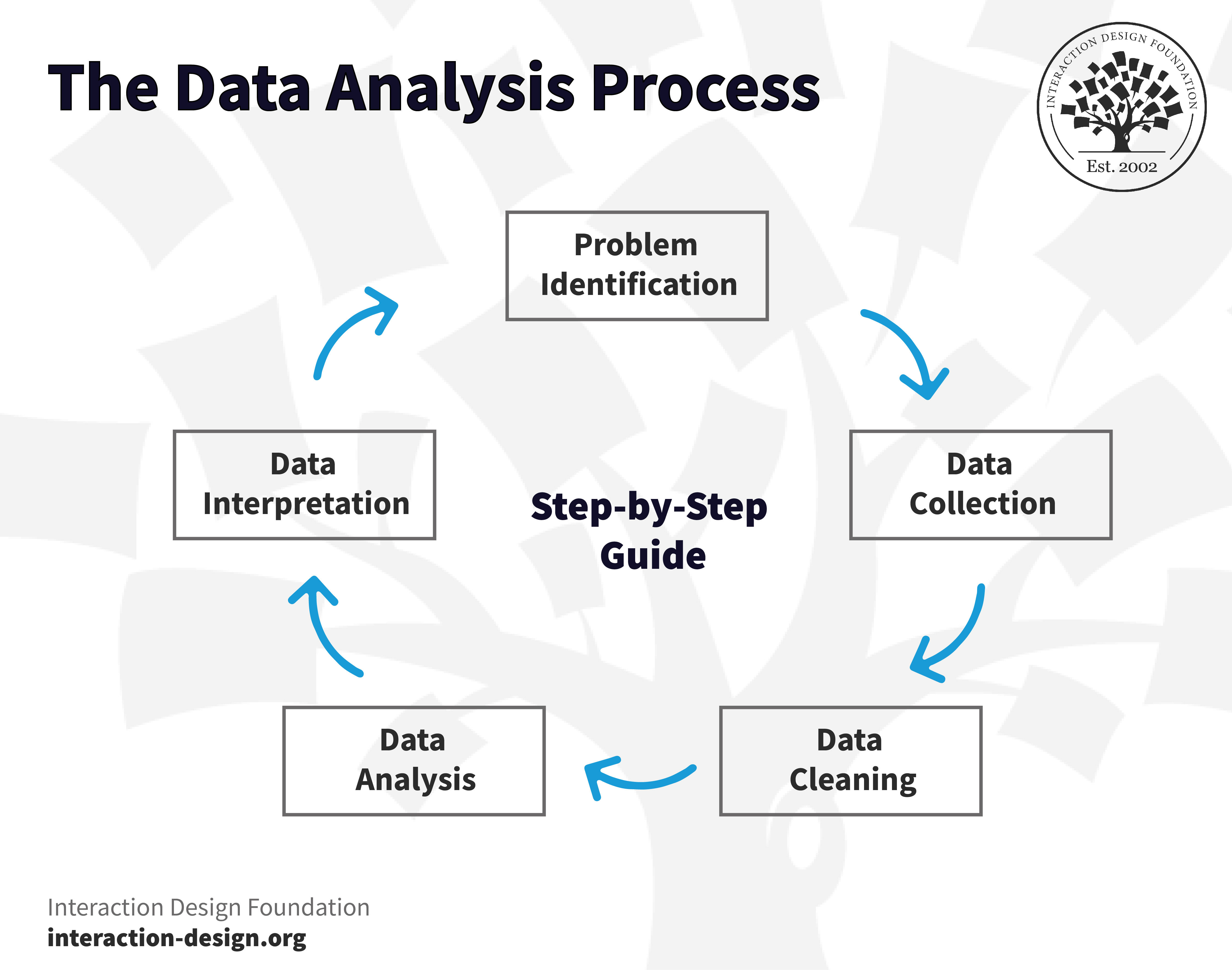
© Interaction Design Foundation, CC BY-SA 4.0
1. Problem Identification
The first step in the data analysis process is “identification.” What problem are you trying to solve? In other words, what research question do you want to address with your data analysis?
Let’s say you’re an analyst working for an e-commerce company. There has been a recent decline in sales. Now, the company wants to understand why this is happening. Our problem statement is to find the reason for the decline in sales.
2. Data Collection
The next step is to collect data. You can do this through various internal and external sources. For example, surveys, questionnaires, focus groups, interviews, etc.
Delve deeper into the intricacies of data collection with Ann Blandford in this video:
The key here is to collect and aggregate the appropriate statistical data. By “appropriate,” we mean the data that could help you understand the problem and build a forecasting model. The data can be quantitative (sales figures) or qualitative (customer reviews).
All types of data can fit into one of three categories:
First-party data: Data that you, or your company, can collect directly from customers.
Second-party data: The first-party data of other organizations. For instance, sales figures of your competition company.
Third-party data: Data that a third-party organization can collect and aggregate from numerous sources. For instance, government portals or open data repositories.
3. Data Cleaning
Now that you have acquired the necessary data, the next step is to prepare it for analysis. That means you must clean or scrub it. This is essential since acquired data can be in different formats. Cleaning ensures you’re not dealing with bad data and your results are dependable.
Here are some critical data-cleaning steps:
Remove white spaces, duplicates, and formatting errors.
Delete unwanted data points.
Bring structure to your data.
For survey data, you also need to do consistency analysis. Some of this relies on good questionnaire design, but you also need to ensure that:
Respondents are not “straight-lining” (all answers in a single column).
Similar questions are answered consistently.
Open-ended questions contain plausible responses.
4. Data Analysis
This is the stage where you’d be ready to leverage any one or more of the data analysis and research techniques mentioned above. The choice of technique depends upon the data you’re dealing with and the desired results.
All types of data analysis fit into the following four categories:
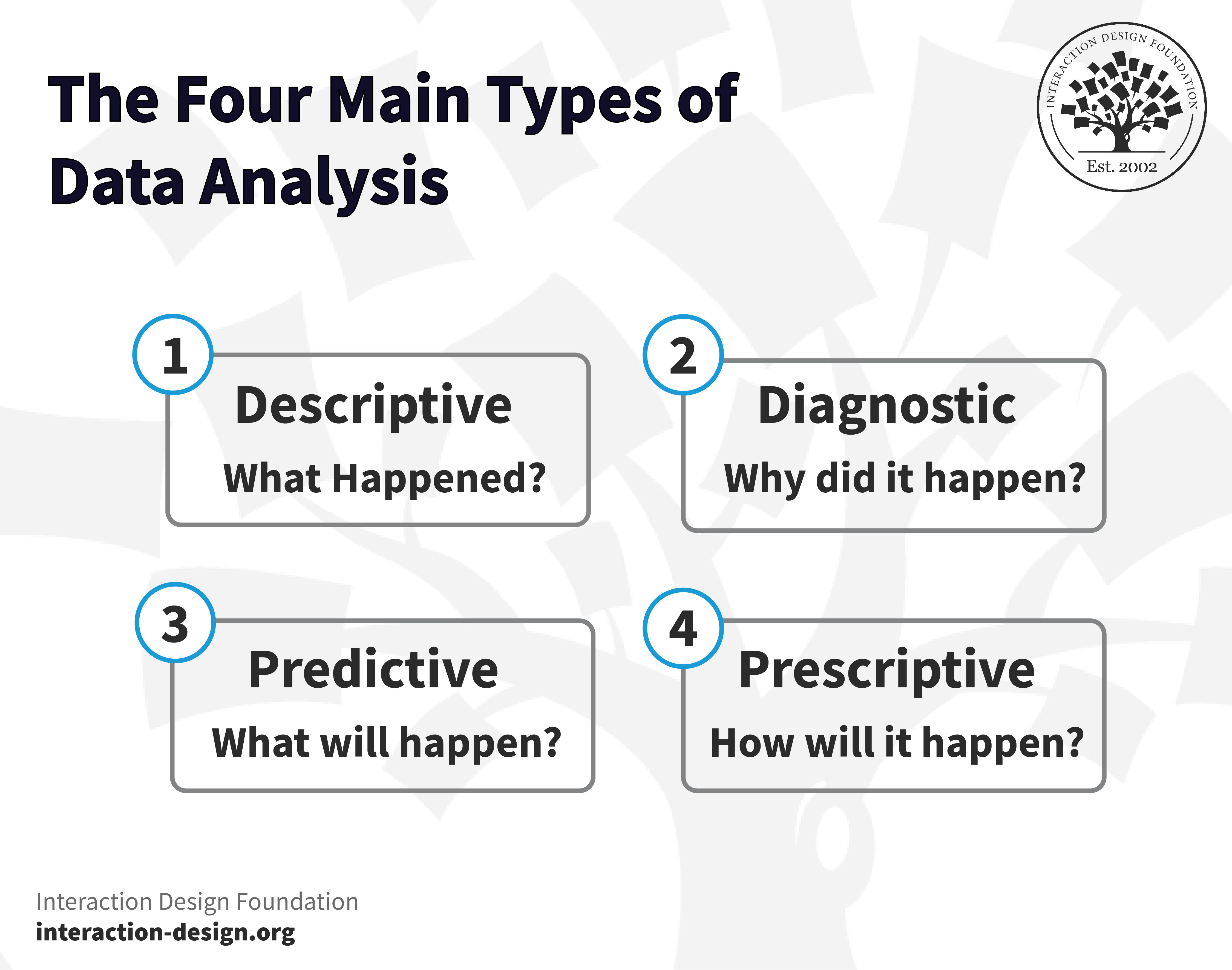
© Interaction Design Foundation, CC BY-SA 4.0
A. Descriptive Analysis
Descriptive analysis focuses on what happened. It is the starting point for any research before proceeding with deeper explorations. As the first step, it involves breaking down data and summarizing its key characteristics.
B. Diagnostic Analysis
This analysis focuses on why something has happened. Just as a doctor uses a patient’s diagnosis to uncover a disease, you can use diagnostic analysis to understand the underlying cause of the problem.
C. Predictive Analysis
This type of analysis allows you to identify future trends based on historical data. It generally uses the results from the above analysis, machine learning (ML), and artificial intelligence (AI) to forecast future growth.
D. Prescriptive Analysis
Now you know what to do, you must also understand how you’ll do it. The prescriptive analysis aims to determine your research’s best course of action.
5. Data Interpretation
The step is like connecting the dots in a puzzle. This is where you start making sense of all the data and analysis done in the previous steps. You dig deeper into your data analysis findings and visualize the data to present insights in meaningful and understandable ways.
Explore this comprehensive video resource to understand the complete user research data analysis process:
The Best Tools and Resources to Use for Data Analysis in 2023
You’ve got data in hand, mastered the process, and understood all the ways to analyze data. So, what comes next?
Well, parsing large amounts of data inputs can make it increasingly challenging to uncover hidden insights. Data analysis tools can track and analyze data through various algorithms, allowing you to create actionable reports and dashboards.
We’ve compiled a handy list of the best tools for you with their pros and cons.
Data Analysis Tool | Type | Ideal For | Best For | Pricing |
Microsoft Excel | Spreadsheet | Business Analysts, Managers | Basic data manipulation | Paid (Microsoft 365) |
Google Sheets | Spreadsheet | Individuals, Small-Medium Businesses | Basic data analysis and collaboration | Free with Paid upgrades |
Google Analytics | Web Analytics | Digital Marketers, Web Analysts | Digital marketing analysis | Free and Paid (Google Analytics 360) |
RapidMiner | Data Science | Data Scientists, Analysts | Predictive analytics | Free and Paid (various licensing options) |
Tableau | Business Analysts, Data Teams | Interactive dashboards | Paid (various plans) | |
Power BI | Business Intelligence | Business Analysts, Enterprises | Business reporting | Paid (various plans) |
KNIME | Visual Workflow | Data Scientists, Analysts | Data science workflows | Free and Open-source |
Zoho Analytics | Business Intelligence | Small-Medium Businesses | Collaboration and reporting | Paid (various plans) |
Qlik Sense | Business Intelligence | Business Analysts, Data Teams | Interactive analysis | Paid (various plans) |
1. Microsoft Excel
The world’s best and most user-friendly spreadsheet software features calculations and graphing functions. It is ideal for non-techies to perform basic data analysis and create charts and reports.
Pros
No coding is required.
User-friendly interface.
Cons
Runs slow with complex data analysis.
Less automation compared to specialized tools.
2. Google Sheets
Similar to Microsoft Excel, Google Sheets stands out as a remarkable and cost-effective tool for fundamental data analysis. It handles everyday data analysis tasks, including sorting, filtering, and simple calculations. Besides, it is known for its seamless collaboration capabilities.
Pros
Easily accessible.
Compatible with Microsoft Excel.
Seamless integration with other Google Workspace tools.
Cons
Lacks advanced features such as in Microsoft Excel.
May not be able to handle large datasets.
3. Google Analytics
Widely used by digital marketers and web analysts, this tool helps businesses understand how people interact with their websites and apps. It provides insights into website traffic, user behavior, and performance to make data-driven business decisions.
Pros
Free version available.
Integrates with Google services.
Cons
Limited customization for specific business needs.
May not support non-web data sources.
4. RapidMiner
RapidMiner is ideal for data mining and model development. This platform offers remarkable machine learning and predictive analytics capabilities. It allows professionals to work with data at many stages, including preparation, information visualization, and analysis.
Pros
User-friendly interface.
Excellent support for machine learning.
Large library of pre-built models.
Cons
Can be expensive for advanced features.
Limited data integration capabilities.
5. Tableau
Being one of the best commercial data analysis tools, Tableau is famous for its interactive dashboards and data exploration capabilities. Data teams can create visually appealing and interactive data representations through its easy-to-use interface and powerful capabilities.
Pros
Intuitive drag-and-drop interface.
Interactive and dynamic data visualization.
Backed by Salesforce.
Cons
Expensive than competition.
Steeper learning curve for advanced features.
6. Power BI
This is an excellent choice for creating insightful business dashboards. It boasts incredible data integration features and interactive reporting, making it ideal for enterprises.
Pros
Intuitive drag-and-drop interface.
Interactive and dynamic data visualization.
Backed by Salesforce.
Cons
Expensive than competition.
Steeper learning curve for advanced features.
7. KNIME
Short for Konstanz Information Miner, KNIME is an outstanding tool for data mining. Its user-friendly graphical interface makes it accessible even to non-technical users, enabling them to create data workflows easily. Additionally, KNIME is a cost-effective choice. Hence, it is ideal for small businesses operating on a limited budget.
Pros
Visual workflow for data blending and automation.
Active community and user support.
Cons
Complex for beginners.
Limited real-time data processing.
8. Zoho Analytics
Fueled by artificial intelligence and machine learning, Zoho Analytics is a robust data analysis platform. Its data integration capabilities empower you to seamlessly connect and import data from diverse sources while offering an extensive array of analytical functions.
Pros
Affordable pricing options.
User-friendly interface
Cons
Limited scalability for very large datasets.
Not as widely adopted as some other tools.
9. Qlik Sense
Qlik Sense offers a wide range of augmented capabilities. It has everything from AI-generated analysis and insights to automated creation and data prep, machine learning, and predictive analytics.
Pros
Impressive data exploration and visualization features.
Can handle large datasets.
Cons
Steep learning curve for new users.
Expensive than competition.
How to Pick the Right Tool?
Consider the below factors to find the perfect data analysis tool for your organization:
Your organization’s business needs.
Who needs to use the data analysis tools?
The tool’s data modeling capabilities.
The tool’s pricing.
Besides the above tools, additional resources like a Service Design certification can empower you to provide sustainable solutions and optimal customer experiences.
How to Become a Data Analyst?
Data analysts are in high demand owing to the soaring data boom across various sectors. As per the US Bureau of Labor Statistics, the demand for data analytics jobs will grow by 23% between 2021 and 2031. What’s more, roles offer excellent salaries and career progression. As you gain experience and climb the ranks, your pay scales up, making it one of the most competitive fields in the job market.
Learning data analytics methodology can help you give an all-new boost to your career. Here are some tips to become a data analyst:
1. Take an Online Course
You do not necessarily need a degree to become a data analyst. A degree can give you solid foundational knowledge in relevant quantitative skills. But so can certificate programs or university courses.
2. Gain the Necessary Technical Skills
Having a set of specific technical skills will help you deepen your analytical capabilities. You must explore and understand the data analysis tools to deal with large datasets and comprehend the analysis.
3. Gain Practical Knowledge
You can work on data analysis projects to showcase your skills. Then, create a portfolio highlighting your ability to handle real-world data and provide insights. You can also seek internship opportunities that provide valuable exposure and networking opportunities.
4. Keep Up to Date with the Trends
Since data analysis is rapidly evolving, keep pace with cutting-edge analytics tools, methods, and trends. You can do this through exploration, networking, and continuous learning.
5. Search for the Ideal Job
The job titles and responsibilities continue to change and expand in data analytics. Beyond “Data Analyst,” explore titles like Business Analyst, Data Scientist, Data Engineer, Data Architect, and Marketing Analyst. Your knowledge, education, and experience can guide your path to the right data job.
The Take Away
Whether you’re eager to delve into a personal area of interest or upgrade your skills to advance your data career, we’ve covered all the relevant aspects in this article.
Now that you have a clear understanding of what data analysis is, and a grasp of the best data analysis techniques, it’s time to roll up your sleeves and put your knowledge into practice.
We have designed The IxDF courses and certifications to align with your intellectual and professional objectives. If you haven’t already, take the initial step toward enriching your data analytics skills by signing up today. Your journey to expertise in data analysis awaits.
Where to Learn More
1. Learn the most sought-after tool, Microsoft Excel, from basic to advanced in this LinkedIn Microsoft Excel Online Training Course.
2. Ensure all the touchpoints of your service are perfect through this certification in Service Design.
3. Learn more about the analytics data types we encounter daily in this video.
Video copyright info
Author: Stewart Cheifet. Appearance time: 0:22 - 0:24. Copyright license and terms: CC / Fair Use. Modified: Yes. Link: https://archive.org/details/CC1218greatestgames
4. Read this free eBook, The Elements of Statistical Learning, to boost your statistical analysis skills.
5. Check out Python for Data Analysis to learn how to solve statistical problems with Python.
6. Join this beginner-level course and launch your career in data analytics. Data-Driven Design: Quantitative UX Research Course
